Last updated on January 17th, 2024.
Cornetti, or little horn, is the Italian version of French croissants. And just like the french pastries, it is as flakey, buttery, and light as air-rolled pastries, and true to its Italian origins; it comes with more passion, some attitude, and a whole lot of love.

A while back, I got a request for a Cornetti (Italian Croissants) recipe for a reader, so I did some research, spent quite some LBs of butter, and now I am more than excited to share this ridiculously delicious pastry. If you are Italian and have some memories or special tricks you learned from your Nonna, please comment below and share them; I would love to hear them!
If you are a fan of Italian pastries, check out these Pignoli Cookies, Zeppole, Torta Della Nonna, and Italian Cream Puffs recipes.
Cornetto VS. Croissant
Cornetti is the plural of cornetto, and while it is very similar to a French croissant, and it there are main differences between the two:
- Both are made using brioche dough, but cornetti dough contains eggs, while croissant dough does not. (Hence the attitude)
- Cornetti are a bit sweeter than Traditional croissants. (Hence the passion)
- Italian cornetto is rolled to the shape of horns, while croissant is rolled into a crescent shape.
- Cornetti are sometimes baked with different fillings, such as pastry cream, Crema Paticciera, Almond Cream, or other sweet fillings, and croissants are usually filled post-bake. They will still taste amazing if filled with Creme Chiboust, Creme Mousseline, and Creme Legere.
Unfortunately, unlike the Maritozzo, here in the States, it’s not as common to find Italian croissants at your local coffee shop as you would an Italian Tiramisu, but after reading this post, you can make it in the comfort of your home kitchen to enjoy a cup of coffee.

Ingredients
Here are the key simple ingredients and some substitution options, if possible:
- Bread flour and all-purpose flour. Combining the two is my ideal texture, but you can use all-purpose flour only.
- Warm milk. Whole milk is preferable, but skim or warm water are good options.
- Granulated sugar. Or light brown sugar if you like the deep molasses flavor.
- Instant yeast. See the recipe card’s notes to convert to active dry yeast and baker’s yeast.
Some French chefs claim that croissant dough also has some lemon zest, but I’ve seen some cornetti recipes doing the same.
How to make Cornetti
You can make this recipe in one day or overnight. Read the below carefully and decide what worked best for you. The full measurements and instructions are in the recipe card at the bottom of this post.
Prepare the butter
There is no right or wrong way to make the block of butter; you can use a large ziplock bag and mark the 9-inch line. Another way is to roll the butter over two pieces of parchment paper, with the bottom one having marks of a 9×10-inch rectangle; make sure to trim the edges and reroll them over the butter.
Ensure the butter is soft enough to be rolled but not too soft, or it will spread too thin (a temperature of 68F is best).
Now, if you are in the mood for a shortcut and don’t mind breaking the roles, freeze the butter, then use a grater to grate the cheese over the dough.
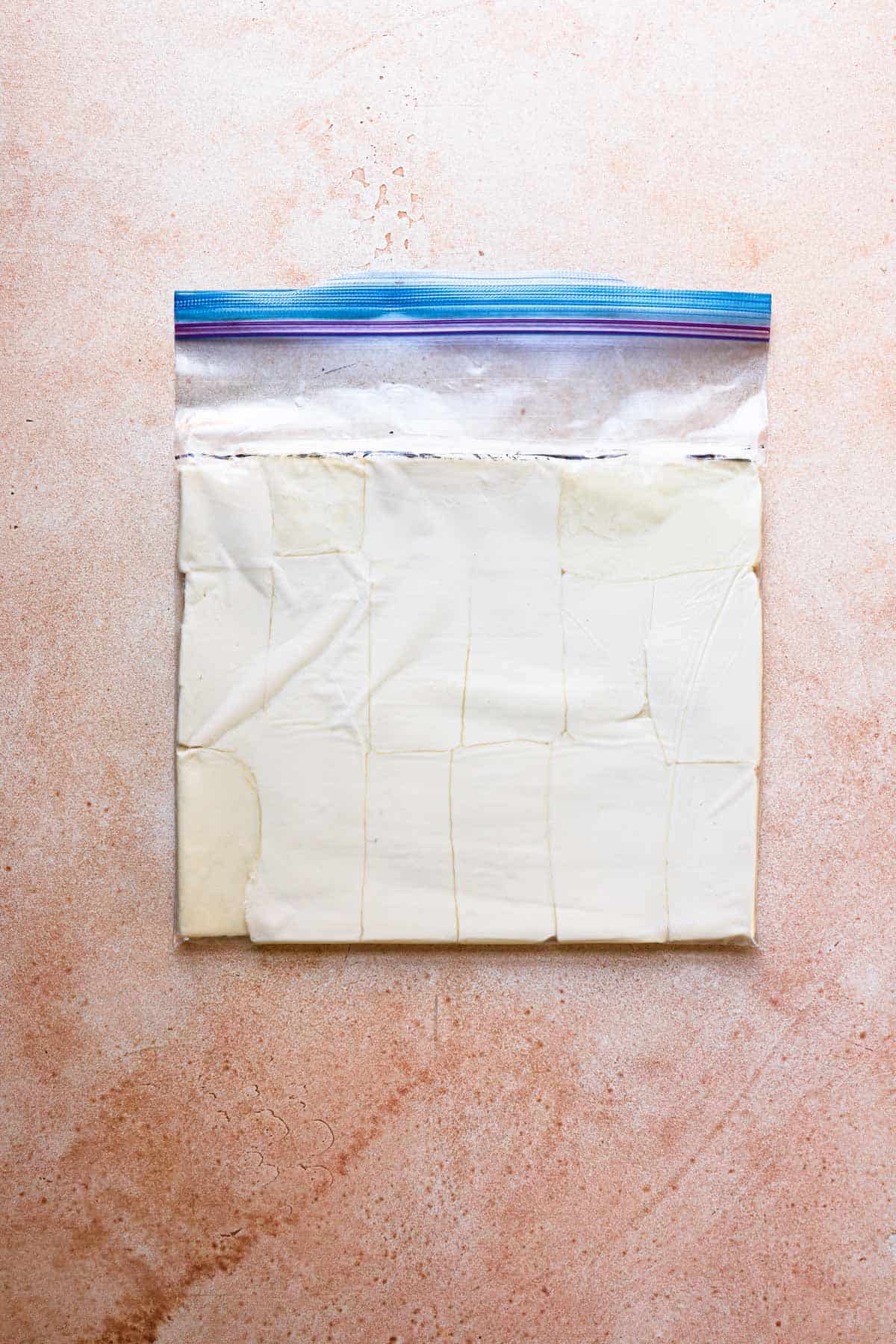
Make the dough
A cornetti dough is similar to my Brioche Dough recipe, but the difference is in how we add the butter. Contrary to Chocolate Brioche or Cinnamon Brioche Rolls, we add a tiny amount of butter to the dough. The remaining butter is incorporated into the dough by lamenting or: rolling and folding it.
The process is simple; we only mix the ingredients to form a dough. But this time, we only knead the dough for about 3-4 minutes because we don’t want to overmix it. As we roll, shape, and fold the dough, we will work and develop the gluten chains. If we over-mix now, the dough will bounce back too much later.
Once it is ready, place it in an oiled bowl, cover and let it sit for one hour, then refrigerate overnight. Or leave it at room temperature for three hours.
And yes, this is the same laminating method for making croissants, puff pastry, Cruffins, and Pain Au Raisin.
Locking the butter
The first step of making laminated dough and creating the layers. As you work, have a bowl with flour, a pastry brush, and a roller next to you.
Remove the butter from the refrigerator and the dough, so the butter will not be too firm. The way to know it is not too firm is by gently bending it; it should not break. It is too warm if it sticks to the wrap as you peel it off.
After folding, look and ensure no gaps between the folds.
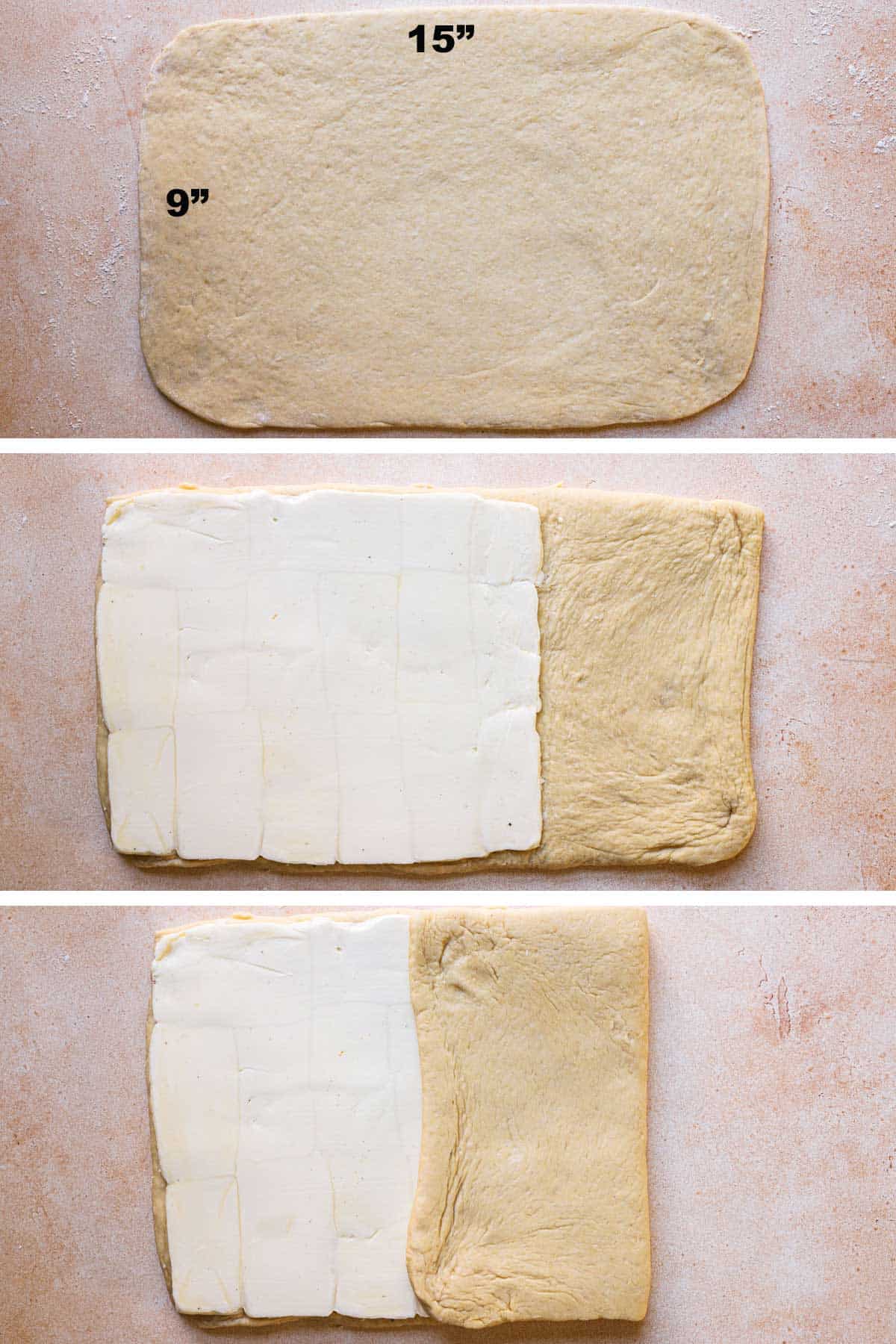
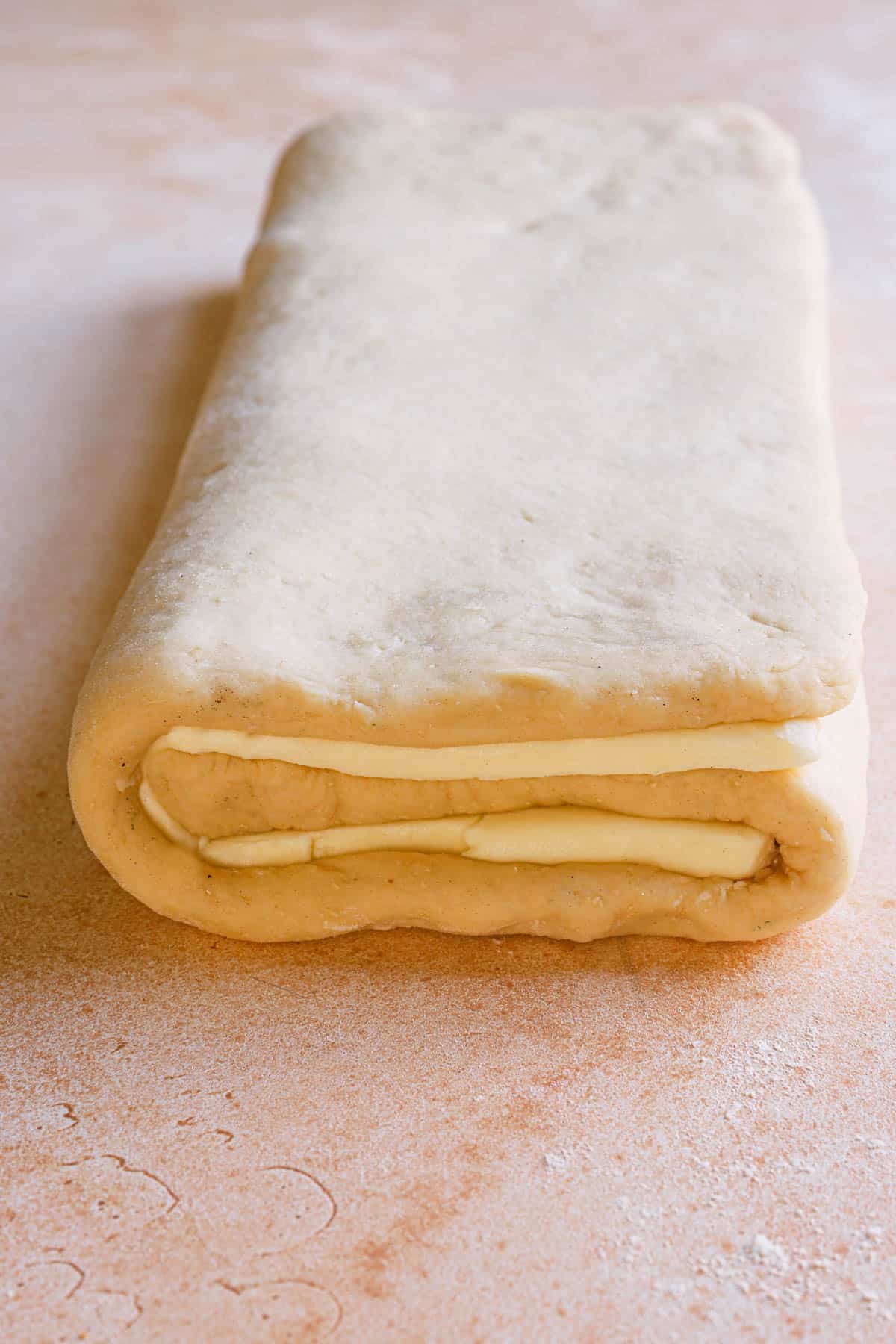
Folding
First fold: the book fold
The book fold divides the dough into four quarters, then folding each side toward the middle, and then we close the book (or dough) by filing one side over the next.
Once you are done, wrap it with plastic and freeze it for 25 minutes.
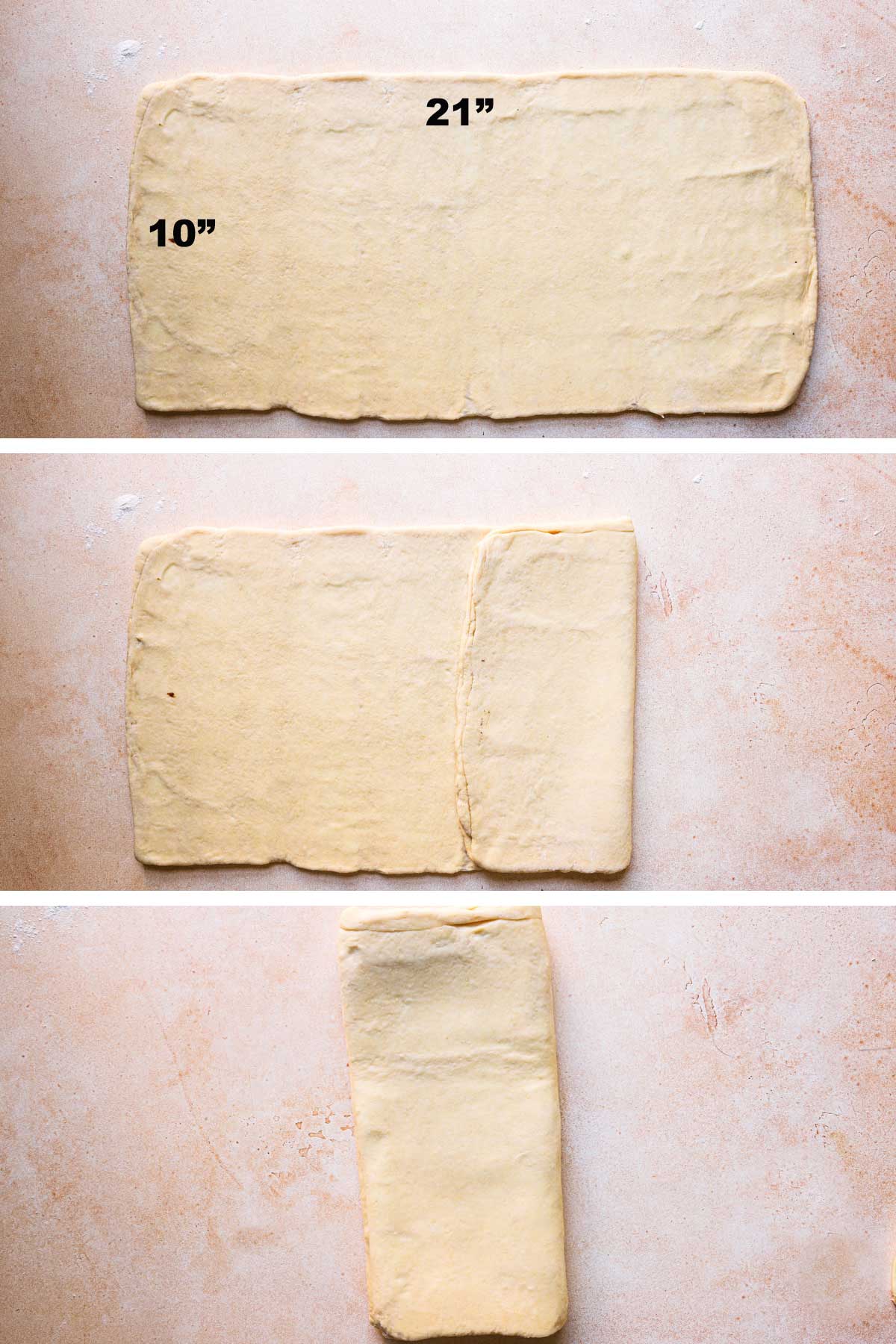
Second and third folds: the three-fold
The next two folds are the same, and please do not be tempted to fold more than three times, or else the butter will weigh itself down, and our Italian cornetti will not rise so high.
In this fold, we will fold the left third side of the rectangle over the center part of, then the last right part over the center.
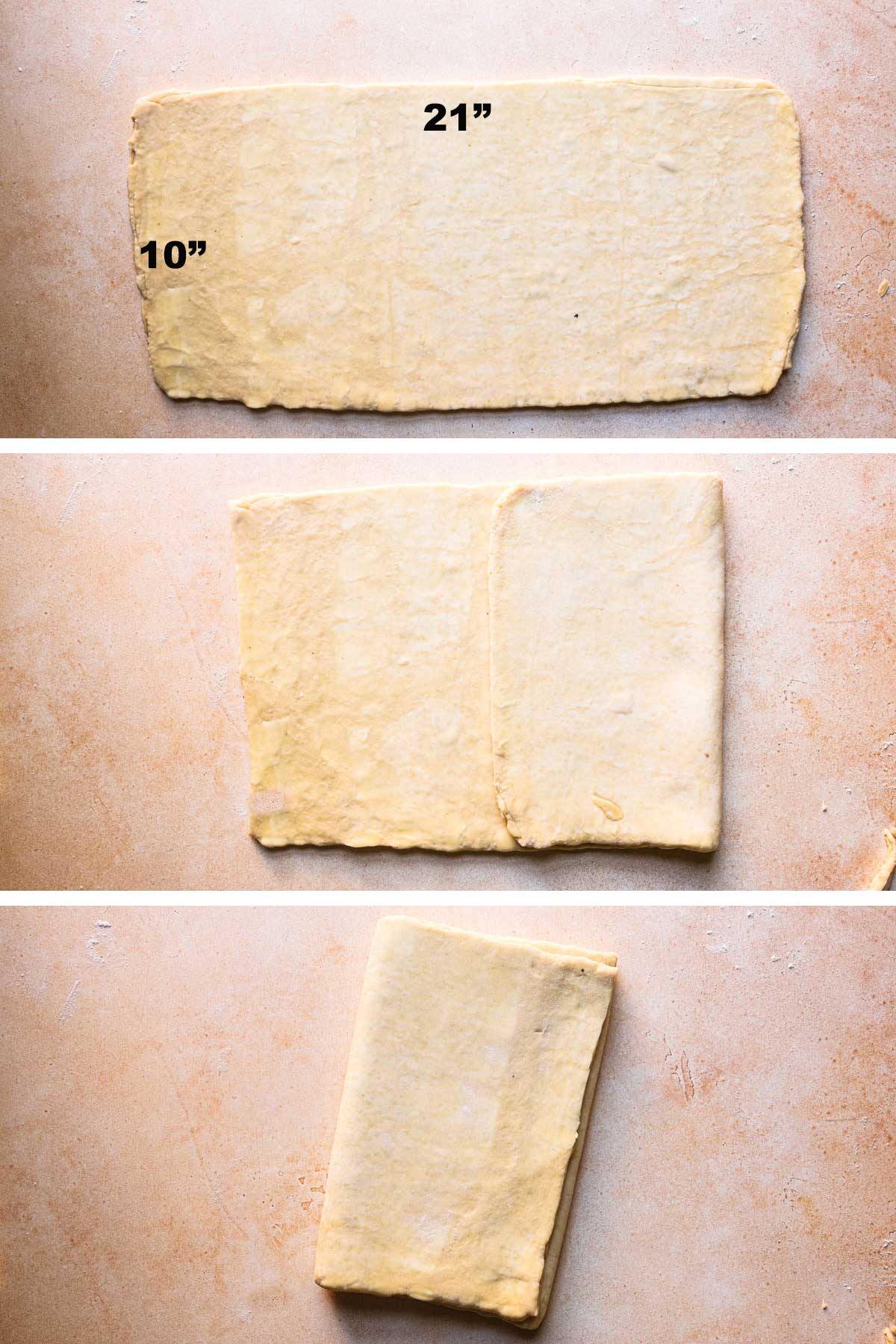
Shaping
This is the fun part! The standard size of a cornetto is like a croissant 4×8-inch triangle, but you can divide the dough and cut the size you wish, do not roll the dough thinner than 1/8 inch. Divide the dough into two, and keep one piece in the refrigerator while shaping.
Roll each piece into an 18×8-inch rectangle. Trim the edges, use a ruler to measure the dough, and cut the dough vertically every 8 inches; you will have two large 8×8 squares and some scraps. Cut the squares diagonally to make triangles.
Gently hold each triangle at its base and stretch it, then roll from the wide side towards the tip.
Place the cornetti over a baking sheet, let rest, and rise for 1.5-2 hours.
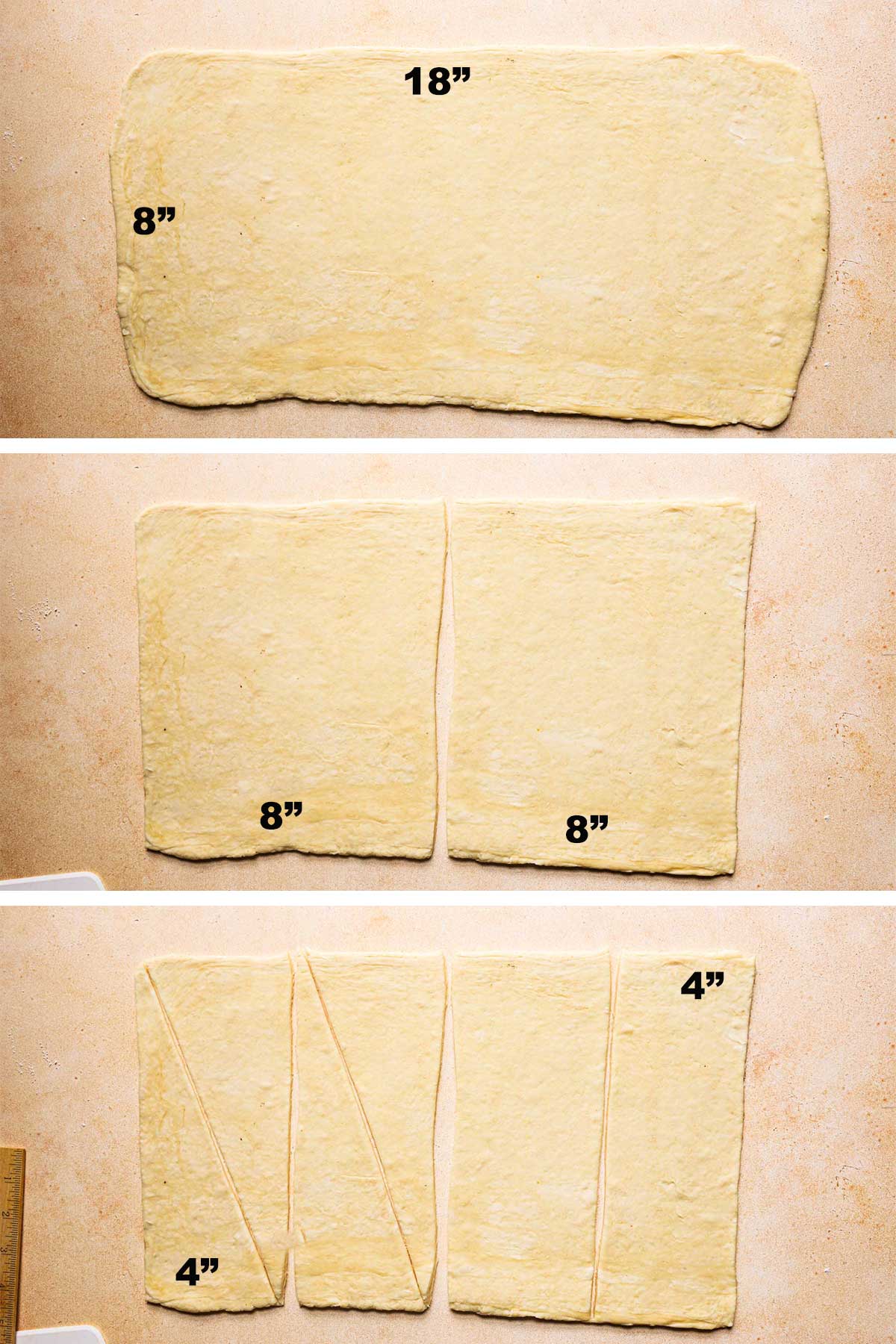
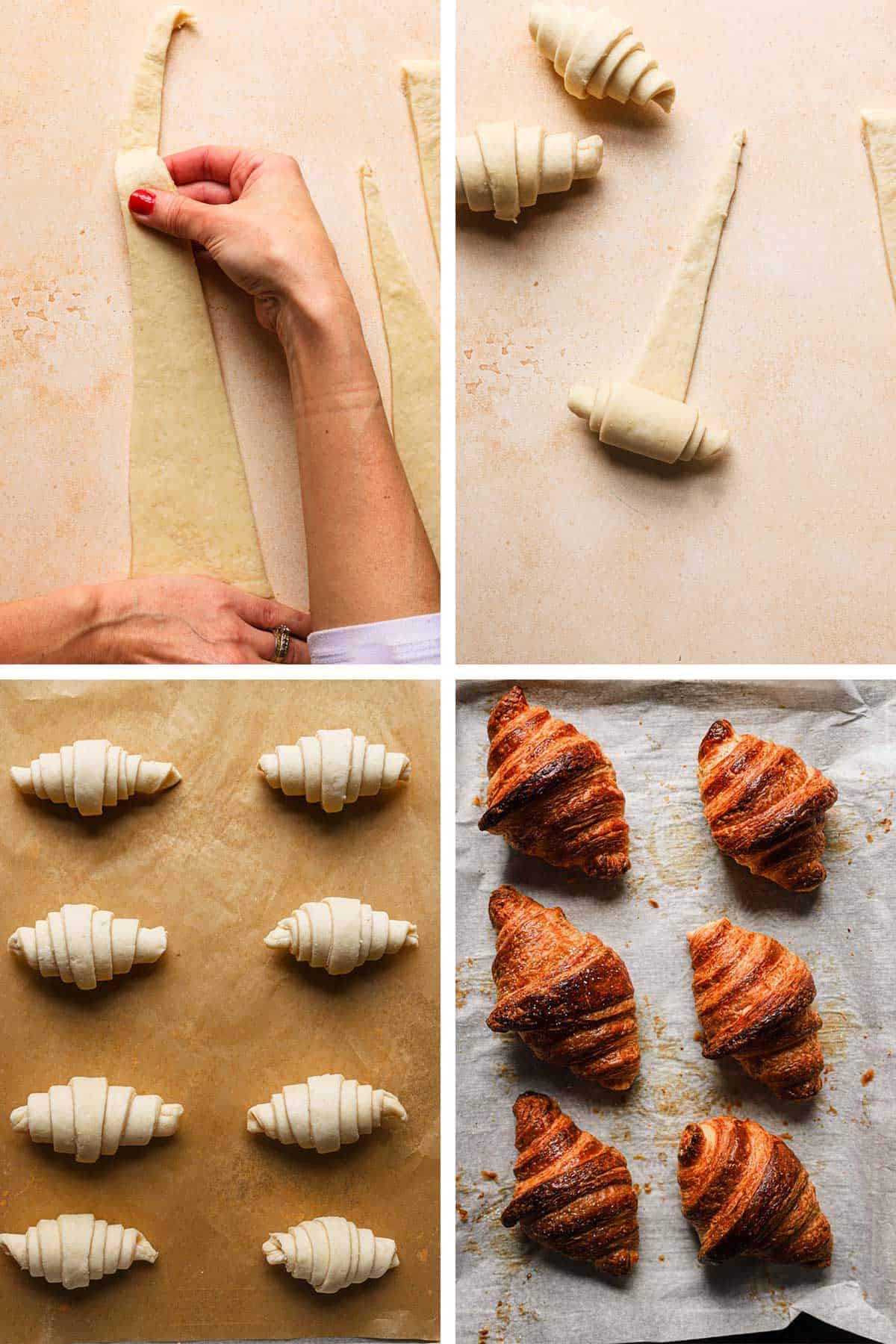

Expert Tips
- Accuracy is very important, so use a kitchen scale (affiliate) for the best results.
- It is best to fold and roll the dough when it is cold, so consider refrigerating it for 2-3 hours, if not overnight.
- The first thing we will do before locking the butter and every fold is tapped the dough with our rolling pin into a 1/2-inch rectangle. If we roll right away, we will “activate” the gluten, and the dough will bounce back.
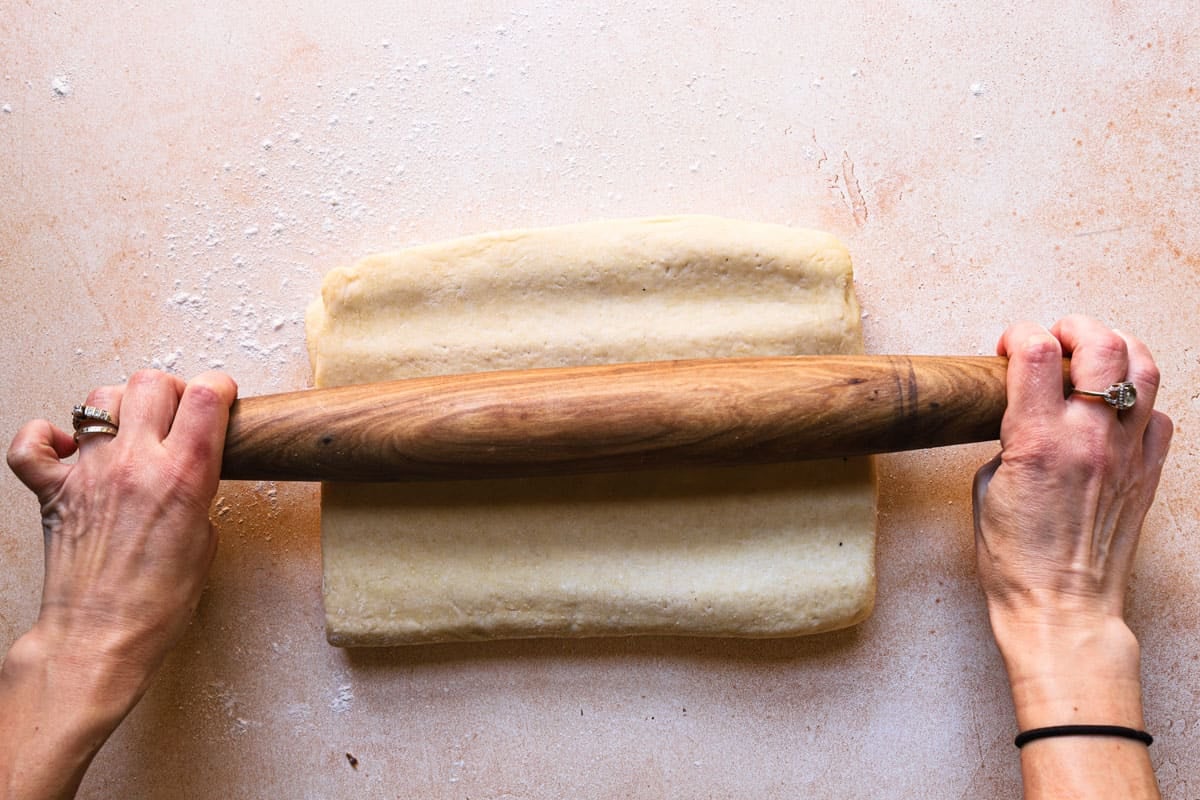
- Use a ruler or a bench scraper to straighten the rectangles as you go.
- Before every fold, take a look at the edges of the rectangle (short side), you should see the layers of dough-butter-dough. If you don’t, that is ok and also very common, use a knife or a pizza cutter to slice a very thin piece of dough to expose the layers (bout 3mm). If this confuses you, skip it!
- Flour your work surface as you go; the dough should move and not stick to your table.
Storing And making ahead
Making ahead: once you complete the lamination processes, you can wrap your dough with plastic wrap and freeze it for up to four weeks. When ready, place in the refrigerator for 8 hours, then continue shaping and baking.
Storing: the Cornetti are best when fresh, up to 24 hours. Leftovers can be stored in a bag or an airtight container for up to 3 days. You can use leftovers to make Almond Cornetto, this delicious Brioche French Toast, or French Toast Casserole.
More Pastry Recipes You Might Enjoy
Chocolate Cream Puffs, How to make pastry choux, Puff Pastry Croissants

Cornetti Recipe
Flakey, buttery and light as air Italin pastries.
Ingredients
Butter Block
- 1 1/2 Cups + 2 Tablespoons Unsalted butter, sliced into 1/2-inch thick vertical stripes. Soft. (350g)
Dough
- 2 Cups Unbleached all-purpose flour (240g)
- 2 Cups Bread flour (240g)
- 1/3 Cup Granulated sugar (70g)
- 2 1/4 teaspoons Instant yeast
- 1/2 teaspoon salt
- 2 large eggs at room temperature
- 3/4 Cup lukewarm milk or water (180ml)
- 2 tablespoons Unsalted butter (25g)
- 1/2 Cup Flour for dusting (may not use all of it)
- 1 Egg Beaten, for egg wash
Instructions
Prepeare the Butter
-
Line the butter pieces next to each other in a large freeze bag. Use a rolling pin to smooth the pices into a large pieces.
-
Refrigerate until use.
Make the dough
-
Place all ingredients in a large bowl of a standing mixer, and mix.
-
Once the dough comes together, mix for 3-4 minutes.
-
Place the dough in an oiled bowl, spray the top with oil spray, and cover it with plastic wrap for 1 hour, then refrigerate overnight. (Or leave at room temperature for 3 hours).
Locking the butter
-
Remove the butter about 20 minutes before rolling and locking
-
Lightly flour your workspace. Use your rolling pin to tap the dough into a 1/2-inch rectangle. Do not roll right away, or the dough will bounce back.
-
Roll the dough into a 9×15-inch rectangle. Use a ruler or a bench scraper to straighten the edges.
-
Remove the butter with its wrap, and place it over the left side of the dough, ensuring no raw dough stretches beyond the butter.
-
Fold the unbuttered part over the butter.
-
Fold the buttered part over the dough.
-
Dust any flour, wrap the dough with plastic wrap, place over a baking sheet, and freeze it for 25 minutes.
Fold # 1- the book fold
-
Remove the dough from the freezer, dust the surface with flour, then tap the dough into a 1/2-inch rectangle.
-
Roll the dough into a 21×10 inches rectangle, and have the dough facing you horizontally.
-
Fold the dough into two, then unfold it again. You should see the marks in the center of the rectangle.
-
Fold the left side towards the center line, and do the same with the right side.
-
Now fold one end over the other.
-
Dust the flour, wrap, and freeze for 25 minutes.
Fold # 2&3 – The third fold
-
Tap the dough over a floured surface until it is 1/2-inch thick.
-
Roll to a 21×10-inches rectangle faving you horizantly.
-
Mentally divide the dough into three parts, then fold the left part over the center part.
-
Fold the right part over the center.
-
Brush off any flour, wrap and freeze for 25 minutes.
-
Repeat this fold one more time, then wrap and refrigerate for 1.5 -2 hours.
Shaping the cornetti
-
Divide the chilled dough into two, and place one part in the refrigerator.
-
Roll over a lightly floured surface into an 18×8-inch rectangle.
-
Trim the edges, and divide the dough into two 8×8-inch squares.
-
Cut each square at the center so you'll have four 4×8-inch rectangles.
-
Cut each square diagonally, so you'll have 8 triangles.
-
Hold each triangle in the base and stretch it gently, then roll it from the wide end toward the tip.
-
Place the horns over a baking sheet lined with parchment paper, cover the cornetti with plastic wrap, and let them rest and rise for 60-90 minutes.
-
Brush with egg wash and bake at 400F (200C) for 15 minutes; reduce the temperature to 350F (180C) and bake for additional 8-10 minutes.
-
Remove from the oven, and enjoy!

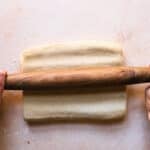
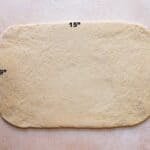
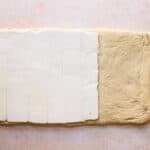
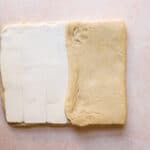
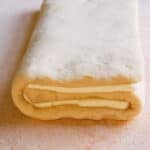
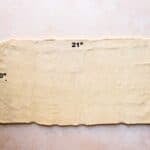
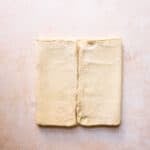
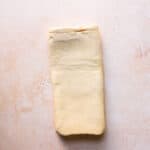
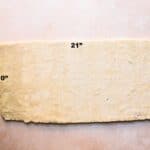
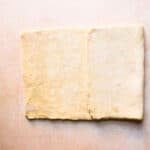
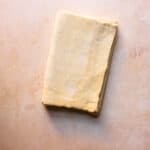
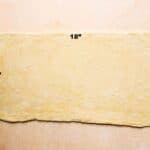
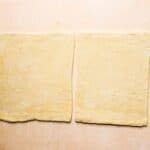
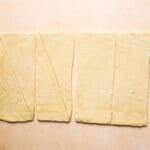

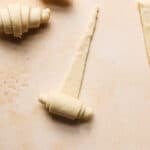

OMG! You are my hero! I lived in Florence many years ago for a year and have been many times. I miss cornetti so much! The best I ever had was from a bakery in Fiesole, called Alcedo. I wanted to watch them make it, but was not permitted. I live in Las Vegas where there is a Eataly and even they don’t make them correctly. They have a “Vuota” which is not a cornetto because it’s not flakey, but they are good in that they use an essence of orange. Could you add orange zest or orange water to your recipe? I tried making cornetti using a recipe from Emika Davies’ book, “Fiorentine, but was not successful. I think it was the yeast. After shaping them, they never rose enough. I look forward to using your recipe. If I am successful, I won’t have to drive 6 miles everyday to get a fresh croissant from a good French bakery here, MG Patisserie – the baker, Michael, was formally the head baker at the Beverly Hills Hotel. Thank you so much! Can’t wait to try making them.
Hi Sherrie,
Thank you so much for your comment, so happy to read you are as excited as I am about this recipe!
From what I know, Vuoto means empty, and it is basically empty cornetto, so I don’t think it is a different pastry.
About adding citrus, YES!!!! Love that. You can add zest from one medium orange to the flour.
Cornneti is made the same way Croissant does, so it’s all in the technique. Read the post very carefully, and take your time!
I’m so excited to make these. I studied abroad in Florence last summer and I can’t explain how much I loved waking up, going to a local cafe, and eating a cornetto! My favorite was a cornetto al pistachio – a cornetto filled with pistachio cream. I have been thinking a lot about my time there lately and missing this amazing breakfast. Thanks for sharing!
That’s so awesome Katherine. Pistachio flavor sounds amazing, I must make it!
Thanks for this comment, love to hear about your Italian travels.
This recipe is great, I made it in one day, started in the morning but waited to bake the shaped Cornetti in the next morning. What a delicous treat it is. Next time I will fill them with different fillings, maybe almonds or chocolate, thank you for sharing.
If I wanted to fill them with pastry cream would I fill them and then bake? Or bake then fill?
It’s really up to you.If you like the cream to be smooth then so it after, otherwise, it will set and become more like a baked cheese filling.
Thank you for the recipe, it came out great and I was very nervous but, I’m surprised that it’s not that hard. Question, how can I make this into almond flavored?
That is so great to hear Samuel. Almond flavored pastries get the flavor from almond filling, like twice baked almond croissant.
I see that it says it makes 16 cornetti at the top but then the recipe says 8. If I change the top to 8 it changes the amounts. Do I use the amounts for 8 to make 8 or the amounts for 16 to make 8?
Each piece of dough makes 8, so it’s a total of 16.